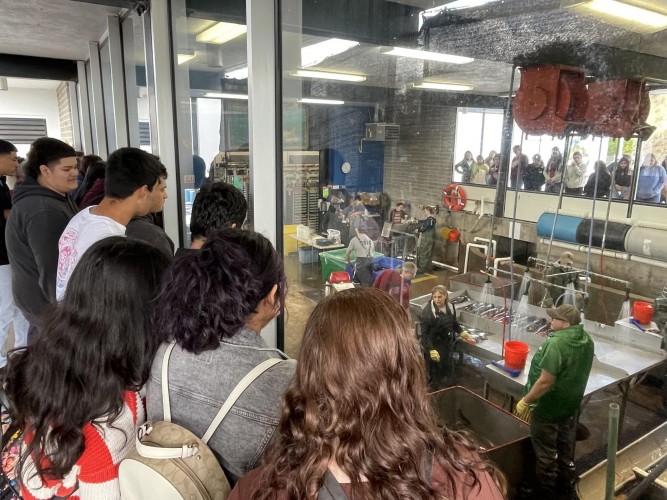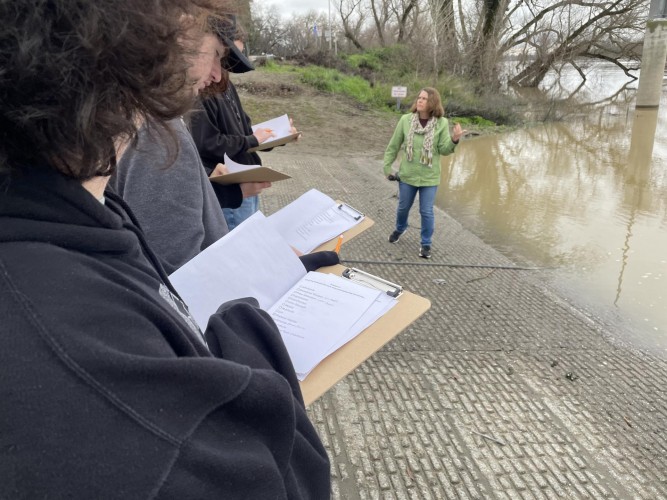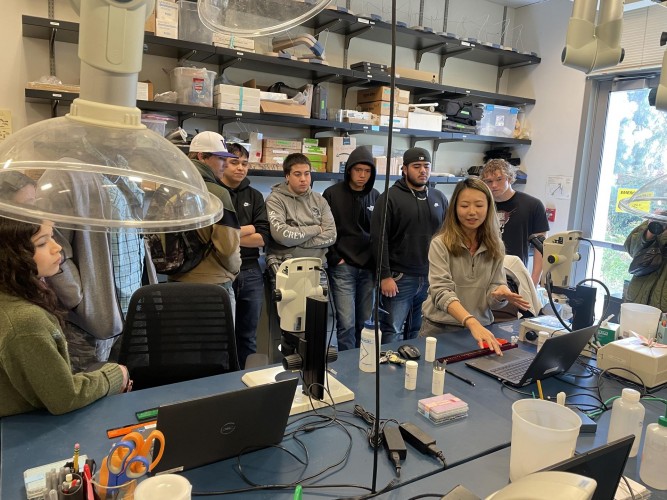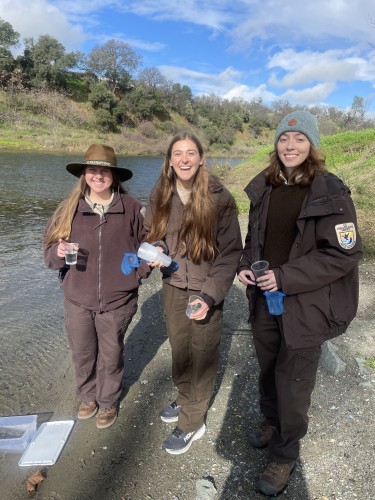Project Update: Connecting Classroom Content in Spinning Salmon Field Trips
 “Bye, Spaghetti!” waved one high
schooler as a tiny Chinkook salmon, so named Spaghetti, swam out
of a plastic cup and into the murky Sacramento River.
Across the boat ramp at Riverbend Park in Oroville, students
said their farewells to the alevin in their own cups. This
was the last chance for students to get an up close of the fish
they spent raising in their classroom over the last 6 weeks.
“Bye, Spaghetti!” waved one high
schooler as a tiny Chinkook salmon, so named Spaghetti, swam out
of a plastic cup and into the murky Sacramento River.
Across the boat ramp at Riverbend Park in Oroville, students
said their farewells to the alevin in their own cups. This
was the last chance for students to get an up close of the fish
they spent raising in their classroom over the last 6 weeks.
While Chinook salmon already face myriad threats – from habitat loss due to dams, warming waters from drought and changing climates, pollution in runoff — there is one more to add to the list. In 2020, fisheries staff began observing unusual swimming patterns, lethargy, and increased mortality in salmon that eventually was attributed to Thiamine Deficiency Complex, or TDC. Lack of thaimine, or vitamin B1, in salmon diets is thought to be a result of “eating too much fatty fast food” as one scientist, Carson Jeffres, describes it (watch a video of him describing the project here). With a change in ocean temperatures brings a change in available food to salmon, and that shift brought abundant anchovies that salmon were mostly eating versus their typical varied diet that also includes other small fish, krill, squid, and other forage species.
 The 2023-2024 school year was the
third year of the Spinning Salmon in the Classroom project. This
project brings students into the mix, collaborating with
researchers studying the effects and treatments of TDC. High
school students in Glenn, Colusa, Tehama, and Solano counties
observe salmon as part of the California Department of Fish and
Wildlife’s longstanding Aquariums in the Classroom program. The
eggs reared in classrooms come from the only 30 females from
Feather River Fish Hatchery that are untreated for TDC. Before
delivery to classrooms, scientists measure the females’ thaimine
levels. Student observations on fish behavior and mortality are
documented, and the data is sent to the research team. This data
contributes to real studies trying to understand what levels of
thaimine untreated salmon in the wild need in order for their
progeny to survive.
The 2023-2024 school year was the
third year of the Spinning Salmon in the Classroom project. This
project brings students into the mix, collaborating with
researchers studying the effects and treatments of TDC. High
school students in Glenn, Colusa, Tehama, and Solano counties
observe salmon as part of the California Department of Fish and
Wildlife’s longstanding Aquariums in the Classroom program. The
eggs reared in classrooms come from the only 30 females from
Feather River Fish Hatchery that are untreated for TDC. Before
delivery to classrooms, scientists measure the females’ thaimine
levels. Student observations on fish behavior and mortality are
documented, and the data is sent to the research team. This data
contributes to real studies trying to understand what levels of
thaimine untreated salmon in the wild need in order for their
progeny to survive.
At the boat ramp, students took note of how the color of the fish changed between the tank and river environments, and observed the small strip of orange on the fish’s bellies that indicated the remainder of the fish’s yolk sac that provided nourishment for fish in the first stage of life. These details are difficult to observe in the tanks as most of the time besides the data collection, the tanks were covered with insulation to help keep the water a consistent temperature. Caring for these fish was one step in the overall protocols, co-developed with the research team, that students and teachers took ownership of this winter.
 For participating schools in the
GEAR UP STEM Rural Valley Partnership Program, fall 2023 afforded
students a chance to visit the hatchery where their eggs were
harvested, fertilized, and first stored. Students and teachers
saw the barrier dam downstream of Oroville dam that forced fish
into the fish ladder and into the hatchery. Members of the
research team provided an introduction to the research and walked
through both the final and first life stages of Chinook salmon
with students.
For participating schools in the
GEAR UP STEM Rural Valley Partnership Program, fall 2023 afforded
students a chance to visit the hatchery where their eggs were
harvested, fertilized, and first stored. Students and teachers
saw the barrier dam downstream of Oroville dam that forced fish
into the fish ladder and into the hatchery. Members of the
research team provided an introduction to the research and walked
through both the final and first life stages of Chinook salmon
with students.
 Field trips to release the
fish in February 2024 had students reflecting on the
protocols in the classroom and how those translated to observing
the ideal habitat needed for salmon at the release site.
Performing a habitat assessment alongside real scientists
provided a first-hand opportunity to not only learn about what
actually goes into caring for these animals, but the different
career pathways students could apply relevant skills and
interests. How cool to be able to someday add “kayaking for
science” to a resume?!
Field trips to release the
fish in February 2024 had students reflecting on the
protocols in the classroom and how those translated to observing
the ideal habitat needed for salmon at the release site.
Performing a habitat assessment alongside real scientists
provided a first-hand opportunity to not only learn about what
actually goes into caring for these animals, but the different
career pathways students could apply relevant skills and
interests. How cool to be able to someday add “kayaking for
science” to a resume?!
 GEAR UP students from Willows High
School also organized a field trip to the UC Davis Center
for Watershed Sciences, which is the home to major research on
TDC. Some of the researchers collaborating with the Spinning
Salmon project perform their research in the very lab students
visited. This exclusive behind-the-scenes opportunity was a
chance for students to meet more of the researchers, learn
about the different science involved in studying TDC, and
experience being in a real scientific lab.
GEAR UP students from Willows High
School also organized a field trip to the UC Davis Center
for Watershed Sciences, which is the home to major research on
TDC. Some of the researchers collaborating with the Spinning
Salmon project perform their research in the very lab students
visited. This exclusive behind-the-scenes opportunity was a
chance for students to meet more of the researchers, learn
about the different science involved in studying TDC, and
experience being in a real scientific lab.
 To further connect classroom
learning to local communities, additional field trips with
community-based partners are planned to take place this spring.
We’re thankful to these partners, including Solano Land Trust,
Fairfield-Suisun Sewer District, The Nature Conservancy’s Dye
Creek Preserve, and the Resource Conservation District
of Tehama County, for collaborating on these additional
field trip opportunities. A huge thanks to participating
researchers, schools, and students for making these fish release
field trips happen!
To further connect classroom
learning to local communities, additional field trips with
community-based partners are planned to take place this spring.
We’re thankful to these partners, including Solano Land Trust,
Fairfield-Suisun Sewer District, The Nature Conservancy’s Dye
Creek Preserve, and the Resource Conservation District
of Tehama County, for collaborating on these additional
field trip opportunities. A huge thanks to participating
researchers, schools, and students for making these fish release
field trips happen!








